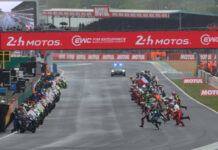FIRST PERSON/OPINION:
By Michael Gougis
The bottom line is this: The federal Environmental Protection Agency says current, existing law does not allow anyone “to disable, remove, or render inoperative (i.e., tamper with) emission controls on a certified motor vehicle for purposes of competition,” and no one has been able to do so legally since 1990.
But the agency’s proposal to “clarify” existing regulations by putting the above wording into a new rule – issued jointly with the National Highway Traffic Safety Administration – has drawn a swift objection from an industry group that represents the aftermarket automotive industry, has drawn objections from private citizens and has even become a talking point in the 2016 presidential race.
And regardless of what the EPA says now, the proposed language directly contradicts documents published by the EPA, which have – for at least 12 years – provided clear, concise assurance that motorcycles used for competition do not have to meet emissions standards.
“This is not a clarification. This is new law, and it goes beyond the scope of the Clean Air Act,” Stephen B. McDonald, Vice President, Government Affairs for the Specialty Equipment Market Association, commonly known as SEMA, told Roadracingworld.com.
The issue strikes at the heart of professional motorcycle road racing in the United States. Virtually every class of motorcycle currently road raced professionally must, according to the rules of the sanctioning bodies, be based on a road-going machine. And that means a bike that would meet emissions standards.
But if the proposed language becomes a rule enforceable by law, it would have a dramatic impact on motorcycle road racing in the U.S. All racebikes, amateur and professional, based on streetbikes would have to meet emissions regulations. At a stroke, every motorcycle racing in the MotoAmerica series – barring, perhaps, the KTM RC 390, as it is sold as a racing-only model – would be in violation of federal emissions regulation, and thus at risk of significant fines. This is because MotoAmerica machines are, by the organization’s rules, production-based, and must be based on a model certified to be operated on the road.
“Motorcycles for the MotoAmerica Superbike Championships must be motorcycles with a valid road homologation in one of the following areas: USA, EU or Japan,” the MotoAmerica rulebook states. “These motorcycles must be available for sale to the public in the shops and in the dealerships representing the manufacturer in at least one of the above areas before the third event of the current Championship to be allowed to be used in the remaining Championship events.”
And it could throw into disarray the business plans of every aftermarket company that makes a part or writes a code that could be used to “disable, remove or render inoperative emissions controls” for an EPA-certified vehicle. Since aftermarket companies have traditionally been major supporters of racing teams, havoc in their operations means less sponsorship money for racers.
Not only is there a potential for a dramatic impact on the aftermarket, there is a potential impact on the racing experience for spectators as well. Noise is part of the drama of motorsport. The most popular motorsports in the U.S. are earth-quakingly loud, and the pre-race burnout in drag racing is a very, very loud announcement that the race is about to start. Racebikes that meet street-legal noise emissions levels will dramatically curtail that part of the appeal. It is not a theoretical problem. Formula One cars are going through a revision this season to attempt to make them louder; the current V-6 hybrids are so quiet that spectators last year complained – and loudly – that the cars did not sound like competition vehicles.
An EPA spokesperson says that the regulation clarification is necessary because competition-only parts and emissions-defeating software that contribute to air pollution continue to wind up on street vehicles.
“The EPA is concerned with aftermarket parts and software manufacturers who sell products that defeat emissions control systems on vehicles used on public roads. This is unequivocally prohibited by the Clean Air Act,” Christie St. Clair, Office of Public Affairs, Environmental Protection Agency, told Roadracingworld.com. “Under the Clean Air Act, tampering with emissions controls in motor vehicles used in racing has been prohibited for all persons since 1990. The proposed regulation creates no new law or policy.
“These manufacturers have claimed their products are used only on competition vehicles. However, their products are designed for EPA-certified motor vehicles and in reality the vehicles are used on public roads.”
The proposed rule would not affect purpose-built racing machines, such as, say, a Moto2 machine, brought into the U.S. strictly for racing purposes.
The dispute arose around a rule proposed in July entitled, “Greenhouse Gas Emissions and Fuel Efficiency Standards for Medium- and Heavy-Duty Engines and Vehicles—Phase 2.” Buried in that document is the following language:
“EPA is proposing in 40 CFR 1037.601(a)(3) to clarify that the Clean Air Act does not allow any person to disable, remove, or render inoperative (i.e., tamper with) emission controls on a certified motor vehicle for purposes of competition.”
And:
“If a motor vehicle is covered by a certificate of conformity at any point, there is no exemption from the tampering and defeat-device prohibitions that would allow for converting the engine or vehicle for competition use. There is no prohibition against actual use of certified motor vehicles or motor vehicle engines for competition purposes; however, it is not permissible to remove a motor vehicle or motor vehicle engine from its certified configuration regardless of the purpose for doing so.”
And lastly:
“Certified motor vehicles and motor vehicle engines and their emission control devices must remain in their certified configuration even if they are used solely for competition or if they become nonroad vehicles or engines; anyone modifying a certified motor vehicle or motor vehicle engine for any reason is subject to the tampering and defeat device prohibitions of 40 CFR 1068.101(b) and 42 U.S.C. 7522(a)(3).”
However, this language clearly contradicts the language in a document prepared by the EPA in September 2002, at least in connection with motorcycles used for competition purposes. The document EPA420-F-02-045, which was visible this past weekend on the EPA’s website, is called “Frequently Asked Questions: Emission Exemption for Racing Motorcycles and Other Competition Vehicles.”
In that document is the following language:
“If you use an EPA-certified vehicle for competition only, it does not need to meet emission standards. This would allow you to modify it however you want, but only if you use it solely for competition …”
The document includes a table that clearly states that motorcycles built before 2005 have no restrictions on use or maintenance, and those built in 2006 or later used “for competition only” have “no restrictions on maintenance or modification.”
Perhaps most disturbing, EPA officials would not respond to a direct inquiry from Roadracingworld.com as to whether putting a full competition exhaust on a streetbike now used exclusively for competition would be legal or illegal. Roadracingworld.com provided an EPA representative a link to an exhaust for a 2016 Yamaha YZF-R1 and asked if it would be legal to install such an exhaust on an R1 that was used exclusively for competition.
The agency’s emailed response: “The EPA will not make any determinations about the legality of this specific product unless and until we choose to investigate it.”
While the official comment period is closed, the EPA is still accepting public comment on this proposal. To comment, go to:
To read the full text of the proposed rule:
To read the EPA FAQ on emission exemptions for motorcycles:
http://www3.epa.gov/nonroad/2002/cleanrec-final.htm
Go to the section on “Additional Fact Sheets.”






